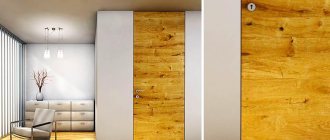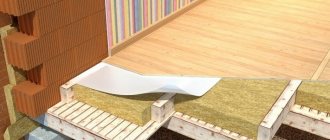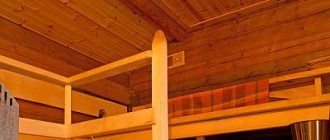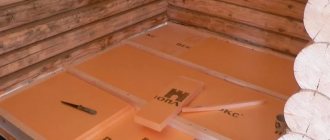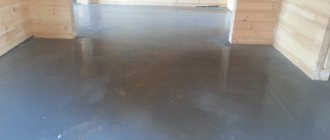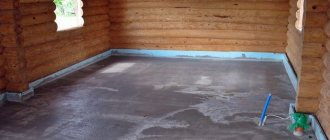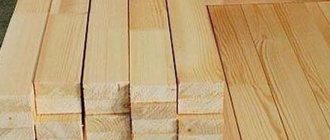Beton-House.com
Website about concrete: construction, characteristics, design. We combine the experience of professionals and private craftsmen in one place
Plywood floor: comfortable and practical
Quite often, when installing floors, decorative materials are used, the installation of which requires a perfectly flat base surface. Many owners of apartments and cottages, trying to make their homes more comfortable to live in, use warmer materials rather than concrete screed to level the floor.
The most popular method is to lay plywood on a concrete floor under laminate or linoleum. The use of sheet wood is explained by its many advantages. The material is affordable and easy to use. In this article we will tell you how to carry out the work correctly and what materials can be used.
- Dispersion composition
- How to glue plywood to concrete?
Plywood
This building sheet material is an excellent choice for leveling the surface, but it is necessary to carefully select both the wood material itself and the methods by which installation will be carried out.
Sheets must be carefully fixed, and they should be selected of a certain quality, with appropriate properties. What types of plywood are there, and what should you pay attention to when purchasing?
Mode of production
In the production of such sheet products, veneer of deciduous and coniferous trees is used. The most common materials for production are birch and pine. The layers are laid taking into account the direction vector of the wood fibers.
Each adjacent material has a different direction vector. The layers are glued together under a press. This production method creates a fairly strong layer that has additional resistance to bending and twisting.
Veneer layers are glued inside a plywood sheet
Gluing veneer in this way leads to improved performance in plywood sheets with low anisotropy. Physical and mechanical properties are evenly distributed not only over the area, but also throughout the entire volume of the sheet. Regardless of the size and thickness of the material, it bends well.
Basic properties
Before laying products on a concrete floor, it is important to determine its characteristics. Plywood can be used both as a substrate and as a finishing decorative coating.
This is due to the excellent performance properties of the sheets, including:
- long service life;
- high strength;
- resistance to deformation;
- relative immunity to humidity (does not swell);
- good thermal insulation qualities;
- guaranteed clear dimensions of sheets with low weight;
- absence of unpleasant odors and harmful fumes.
To determine the required material, you should understand the marking system for sheet wood.
Variety
Indicated by Roman numerals or the letter E: E, I, II, III, IV. The addition of the letter “x” in the grade designation means that the sheets are made from softwood.
This gradation divides them according to the structure of gluing layers, the quality of the front and back layers:
| Variety | Standard permissible number of defects (deciduous wood) | Variety | Regulatory permissible number of defects (coniferous species) |
| E | Not acceptable | Ex | Not acceptable |
| I | 3 | Ix | 6 |
| II | 6 | IIx | 9 |
| III | 9 | IIIx | 12 |
| IV | No limits | IVx | No limits |
Sometimes in construction stores you can find sheets marked grade V/V (5/5) or 6/6. Don't be fooled. This designation indicates that the material does not comply with GOST.
You can also hear the term “shop”. In this way, some manufacturers designate chipped edges of a plywood sheet without delamination.
On a note! Pine plywood has less structural strength, but bends better, and, in the guise of a birch product, its price is more affordable.
Varieties differ visually
Marking
Plywood for concrete should be selected in accordance with its performance properties. To do this, you should understand the labeling and understand the meaning of the symbols indicated on the packaging. In addition to grade, the material is divided into brand or level of moisture resistance, surface roughness and safety class.
Table of marking values:
| Marking | Designation symbols | Characteristic | Note |
| Brand | FSF | increased water resistance | Resistance of the material to changes under the influence of high humidity |
| FC | moisture resistant | ||
| FKM | increased water resistance | ||
| FBA | non-waterproof | ||
| Surface | NS | not polished | During the manufacturing process, the sheet can be sanded on one or both sides, or go on sale unsanded |
| Ш1 | polished on one side | ||
| Ш2 | polished on both sides | ||
| Safety class | E1, E2, E3 | E1 - no more than 10 mg, E2 - from 10 to 30 mg | Indicates the amount of formaldehyde and other harmful substances used in manufacturing. |
In addition to the specified characteristics, dimensions and thickness must be printed. You can see what the markings look like in the photo below.
Example of product labeling on packaging
Finishing
Further processes involve preparing the plywood for laminate flooring.
- The reliability of fixing the parts is assessed; for this purpose, the surfaces are tapped with a wooden block. A dull sound indicates that a void has formed between the floor and the slab. In this case, it is necessary to re-lay the plywood.
- If differences in height of more than 2 mm are observed, then grinding is carried out with special electrical devices. Minor errors are leveled out using a substrate under the laminate. The material must be laid evenly, so the joints are taped. This layer hides minor imperfections and promotes sound insulation.
- Finish cladding panels are attached.
For large differences in height, careful sanding of the plywood flooring is a mandatory procedure, since mismatches between adjacent sheets will subsequently lead to the destruction of the laminate joints.
Correctly performed procedures allow you to obtain a reliable and durable plywood floor that is suitable for any finish.
Material selection
Can these products be laid on a concrete floor? Of course, you just need to choose the right sheet material and fastening method.
- The choice depends on the type of floor installation. If you plan to lay it on joists, then it is better to give preference to birch plywood; it is stronger and bends less easily.
- Leveling a concrete floor by gluing squares onto the base can be done from softwood sheets.
- If the material is not a finishing material, then grade 3 or 4 sheets, unsanded, or sanded only on one side, are suitable.
- The level of moisture resistance should be selected based on the purpose of the room.
On a note! Before purchasing, draw a floor plan and “lay out” the sheets. This fitting will allow you to select the optimal dimensions of the sheets when purchasing in order to minimize waste. Try not to place joining seams in areas of greatest load on the floor.
Measure seven times: cutting and fitting sheets
Cut sheets of the same shape.
Experts recommend 0.6 by 0.6 m, but you can do 1 by 1 m or 1 by 0.5 m - it all depends on the thickness of the plywood and ease of use. After cutting, the sheets are tried on: laid on the floor, following the “staggered” method - the transverse joints should not match, the appearance of the laid sheets resembles brickwork (read: “How to lay plywood on the floor - laying rules”). You should ensure that the damping distance is maintained during installation: a gap of 2 - 3 cm from the wall, 0.5 - 1 cm between sheets. If the fitting was successful, the sheets are numbered so that the final attachment of the plywood to the wooden floor goes smoothly, without a frantic search for the right sheet. In addition, it is useful to draw a plan for laying sheets with the corresponding numbering. Finally, you should mark the floor with a pencil or chalk so that you know where to place the joists. Note: cut plywood is inspected for defects formed during cutting; delaminated or deformed ends of the sheets will affect the quality of the coating; it is better to replace them.
Glue as fastening material
Having decided how to choose sheets, let's move on to selecting the adhesive mixture. The quality of the flooring largely depends on what material is used when installing the products. For the installation of the substrate, the adhesive should be selected especially carefully.
Laying plywood using an adhesive solution can be done with the following solutions:
- water-dispersed;
- alcoholic;
- two-component.
What are the pros and cons of each possible adhesive?
Dispersion composition
Environmentally friendly product. The composition does not require a solvent. Before use, dilute with water to the required consistency.
Consumption is approximately 1.2 kg/1m2. When dried, this composition does not emit anything other than harmless water fumes, and therefore has no odor.
It is precisely this harmlessness and environmental friendliness that determines the disadvantages of working with it:
- The solution takes a very long time to dry, on average at least 7 days.
- Installation of plywood using dispersion compounds requires additional fastening of the sheets to the floor with nails.
Parquet adhesive can be used for laying plywood
- Due to the large amount of water in the composition, it is recommended for use when working with moisture-resistant types of plywood.
Important! Using this fastening method is quite problematic if communication cables were installed in the screed. It is necessary to have a clear plan for their location so as not to get a dowel-nail into the communications.
Alcohol or resin based
Alcohol glue is made on the basis of artificial resins or solvents. When working with it, it is recommended to use a respirator. This is due to the peculiarity of the material: it has a strong toxic odor.
As in the previous case, it is the composition that determines the advantages of this type of glue:
- fast setting and drying time;
- in addition to gluing, it performs the function of minor repairs to the base, filling cracks and small chips;
- During operation, it retains elasticity throughout the entire period.
It is recommended to use additional fastening with nails only in high-traffic areas. Average material consumption is approximately 1.5 kg/1m2.
Polymer composition for laying any type of wood
Two-component compound
Using this adhesive for installing plywood, you get significant advantages over previous compounds, but the price of this product is much higher.
Advantages:
- firmly fixes the material on the concrete surface, which eliminates the need to use nails;
- sets on average within 24 hours, after which the surface is ready for further processing;
- has the highest fastening strength and longest service life.
The instructions on the package will explain how to knead correctly and in what proportions. Due to the short life span of the glue, it is not recommended to prepare it in large quantities. Read the special instructions carefully, the composition may be toxic.
The two-component composition requires careful mixing proportions.
Which variety to choose
To determine which plywood to choose for your floor, you should consider the existing varieties. Plywood is classified according to the following criteria:
According to wood material
Plywood can be made from softwood and hardwood. Hardwood material has higher mechanical properties, but is also more expensive
By moisture resistance
Moisture resistance directly depends on the adhesive composition used in plywood. For example, FBA plywood uses natural albumin-casein glue, so it is resistant to moisture. FSF plywood contains formaldehyde glue, which ensures high moisture resistance
By defects
Based on the presence of knots, wormholes, curls, etc. in the veneer, 4 grades of plywood are distinguished. Grade I is the highest quality and most expensive, grade IV has a large number of defects
For surface grinding
Plywood can be sanded on both sides (Sh2), sanded on one side (Sh1) or unsanded (NS)
By number of layers
There are three-, four-, five-layer and multi-layer plywood
There are many varieties of materialSource amazonaws.com
To determine which plywood is best to lay on the floor, you need to know the conditions of its use. The room where the subfloor will be laid must be heated. Temperature changes are allowed within 16-28 °C. The relative humidity in the room should be within 60%.
If you plan to make a substrate in rooms with low humidity levels (bedroom, living room, hall), you should use FBA plywood, as this is the most environmentally friendly material. In rooms with humid air, it is better to use moisture-resistant varieties - FK or FSF.
A typical solution to the question of which plywood is best for the floor is to use birch plywood Ш1 or Ш2 grade II or III with a thickness of 10-22 mm. This solution combines a fairly high quality surface combined with an acceptable cost.
It must be said that the thickness of the plywood should be 2-3 times thicker than the final floor covering. Using thick plywood will provide greater rigidity to the subfloor, but working with such material will be inconvenient. In addition, the price of plywood will be higher.
Mid-price plywood is suitable for the substrate. Source remontnik.ru
Advantages and disadvantages of plywood flooring
“Planting” sheets on glue is a fairly common method of leveling a concrete floor.
The popularity of this method is due to its advantages:
- this type of work can be easily done with your own hands;
- the material is quite affordable in cost;
- the flooring will become an additional heat and sound insulation layer;
- wood is an environmentally friendly, strong and fairly durable material.
Of course, there are several limitations to the use of sheet plywood, but they are very minor:
- In rooms with high humidity levels, you should use material labeled FSF, and this is not exactly a budget option.
- If the concrete screed has significant differences, it will not be possible to install the flooring using glue: plywood is laid after the base is leveled.
Important! Before starting work, you should check the moisture level of the base. If it is increased, a layer of waterproofing should be laid or the concrete should be treated with a deep penetration primer.
Bitumen mastic can act simultaneously as both a waterproofing and an adhesive mixture
Preparing the base
It is necessary to remove the old floor covering, inspect the concrete base for cracks, chips, and unevenness. The base of the floor can be leveled with a self-leveling mixture or simply repaired cracks and chips with cement mortar. If there is a large difference in height, it is better to make a new concrete screed. For more information on preparing the foundation, watch this video:
Before laying plywood, you need to prime the surface. You can use primers or regular deep penetration formulations.
Plywood can only be laid on a completely dry floor.
Glue or logs
Fastening plywood can be done in two ways:
- using glue when installation is carried out directly on a concrete base;
- if the condition of the base is not ideal, you can lay it on logs.
In addition to differences in the installation method, these methods can eliminate various problems. They are selected depending on the need to solve a specific problem.
Installation of flooring under laminate
How to glue plywood to concrete?
First of all, as usual, we prepare the base. We clean and dust the concrete. We remove all peeling parts and eliminate cracks. We impregnate the base with a deep penetration primer to improve the adhesion of the glue to the screed.
It is better to use a primer with antibacterial properties to prevent mold and mildew from developing in the cake floor. The concrete is processed with a roller, in at least 2 layers. The second is applied after the first has completely dried.
Further, all work occurs in the following order:
- Plywood is cut into equal squares. Usual cutting dimensions: 40*40 or 80*80 cm. Layout and fitting are carried out, and if necessary, the squares are adjusted to size. The squares are laid with the seam offset, in a checkerboard pattern. During the fitting process, the squares are numbered, which will greatly simplify installation with glue.
Cutting is done using a jigsaw
- The selected composition is prepared for installation.
- According to the cutting, laying the squares begins from the far corner of the room. The glue is applied with a notched trowel to the floor surface. The square is placed on the floor area with the desired side (not sanded towards the base) and pressed down.
The specialized mixture is applied to the base with a wavy spatula
- Some types of adhesive mixture require additional fixation of sheets with dowels to the floor. If such a composition is chosen, then it is better to drill the sheets around the perimeter and in the center before laying.
- All squares are laid in compliance with the seam, the distance between the parts of plywood should be 2 - 4 mm. Be sure to check the horizontal position of each square and the entire coating as a whole.
Laying is carried out with offset seams, the width of which must be at least 2 mm
- After the glue has set, you can proceed to further finishing work. The places where the self-tapping screws are drilled are puttied. If necessary, the floor is sanded.
Plywood flooring perfectly levels the floor
Device according to logs
How to attach plywood using joists to a concrete base? Floor preparation is similar to the previous method. The only difference is that perfect evenness is not required here.
After priming, we move on to installing the lag:
- Prepare timber of the required height and length. When fixing the logs to the floor, strictly maintain the horizontal direction using a building level. Check the installation of each beam separately and check the level of adjacent logs.
- In order to simplify the process, you can stretch rope beacons between the walls at the desired level. The logs are attached to the base of the floor through a backing, with which you can adjust the height of the beam.
- This method makes it possible to install an additional layer of thermal insulation. Before laying the flooring and installing the timber, consider the width of the insulation. The size between the joists should be equal to the size of the thermal insulation. When laying products in niches on the floor, the presence of unfilled spaces will lead to a significant deterioration in the insulating properties.
Laying along joists is also an excellent way of additional insulation
- Sheets of plywood are screwed to the joists with self-tapping screws. The material is mounted, as in the previous method, with the seams offset. This is done to properly distribute the load over the floor surface.
On a note! Before you start laying with joists, check the dimensions of the sheet. It should be laid on 3 beams. If necessary, transverse beam inserts should be installed.
The video in this article will tell you how to correctly calculate the distance between the beams, lay thermal insulation and lay sheets.
Step-by-step guide to laying sheets
The work of laying plywood on a concrete floor yourself consists of several technological stages. By following the instructions, you will cope with all the necessary activities on your own, without involving third-party contractors and significantly saving on their services.
First stage. Checking the moisture content of the concrete base
Determination of concrete moisture content using a sclerometer
Before starting work, the contractor must check the moisture content of the base. If this indicator exceeds the permissible values, in the future the plywood will simply delaminate. Surface humidity can be checked without special instruments, using plastic film and several suitable weights. Do the following:
- spread plastic film over the concrete floor;
- Press down the edges of the material with any suitable weight. The center of the plastic film must be free. Leave the homemade structure for several days. To obtain the most reliable results, experts recommend keeping it for a week;
- Check the condition of the film after the specified time. If condensed moisture appears under the polyethylene, you cannot lay plywood on such a floor. Before this, work must be done to create an additional waterproofing barrier. To do this, use the appropriate compositions.
Second phase. Cleaning the base
Grinding the concrete base
First of all, sand down any uneven surfaces. To do this, you can use a grinder with an appropriate attachment. Next, you need to eliminate the remnants of old mixtures (putty, paint, etc.) and fill in the recesses, if any. To eliminate cracks and other similar defects, various mixtures are suitable, for example, cement-sand mortar.
Particular attention must be paid to the stage of cleaning the base from dust. If possible, it is recommended to use an industrial vacuum cleaner for this purpose. In the absence of such a unit, you can get by with an ordinary broom, but you will have to spend much more time on cleaning.
Cleaning the concrete surface
Third stage. Base primer
Base primer
Experts recommend giving preference to the so-called. primers. The product is applied using a paint roller and has a number of advantages over conventional primer, including:
- high rates of surface dust removal;
- good penetration depth - this ensures higher strength of the top layer of the floor structure;
- the ability to increase the rate of adhesion of different materials.
Fourth stage. Laying plywood
By this stage, you have already cut out the sheets and adjusted the elements to the area of the room. Proceed to laying plywood, focusing on the previously completed numbering. The work is performed in the following sequence:
- the base (concrete floor) is covered with plywood glue. The recommended layer thickness is up to 2 mm. Helpful advice: consistently apply glue to small areas of the base so that you have time to lay out the plywood before the binder begins to set;
- plywood is laid on the lubricated base in accordance with the previously established pattern;
- the sheets are additionally fixed using self-tapping screws along the perimeter and diagonally. Screw in the screws in increments of 150-200 mm, the distances from the edges of the flooring elements are no more than 20 mm. Use fasteners that are at least 3 times the thickness of the plywood sheets. For example, if you chose 12 mm plywood, fix it with 40 mm long self-tapping screws;
- process the laid plywood with a sanding machine with an appropriate attachment or sandpaper. Careful grinding allows you to get rid of minor differences in the height of adjacent sheets, eliminate burrs and other minor defects.
Fifth stage. Checking work
Carefully inspect the equipped surface. Make sure that the plywood sheets do not touch the walls. Check for gaps between individual elements.
Additionally, you need to make sure that there are no differences in surface height. The maximum acceptable difference is 2 mm.
Finally, you need to carefully tap the surface with a wooden block or a hammer of the same material. If a dull, inhomogeneous knock is detected, the work will have to be redone, because
Such manifestations indicate peeling of plywood from concrete.
Any type of floor covering can be laid on a flat plywood floor.
Good luck!
Expert advice
What should you do before laying plywood on a concrete base? There are some very simple steps that will nevertheless significantly improve the quality of the floor, regardless of installation method.
- Before starting work, let the wood rest for several days in the room where the flooring is planned. In this case, the indoor humidity should not exceed 18%. If the humidity level is higher, then during operation the timber or the sheets themselves may become deformed.
- Seasoned wood must be treated with impregnating compounds of various properties. Don't neglect fireproofing and insect repellent treatments.
- If a decision is made to lay the material in 2 layers, then the second one must be laid with glue and screws with the seams offset relative to the first flooring.
Diagonal offset option
- When attaching to joists, use black wood screws. Their length should be chosen depending on the thickness of the sheet, but not less than 35 mm. You should not use nails; this fastening will become loose over time and the floor will begin to creak.
- Remember to leave a gap between the wall and the plywood decking. Wood is “living”; it tends to change slightly in size depending on the microclimate in the room.
- When laying decorative materials on top of plywood: laminate, parquet, linoleum, be sure to use a backing.
Using a substrate
How to lay plywood under laminate on wooden and concrete floors
Laminate is the newest material of all known floor coverings.
It was created based on the experience of many years of operation of other coatings; all the advantages and disadvantages of the materials existing at that time were taken into account. Laminate received all the best properties of alternative coatings and quickly won its niche in the market and its admirers.
Durability, high aesthetic performance, and the possibility of a wide choice of external coating types quickly made the material one of the leaders among floor coverings.
Ease of installation and the possibility of self-installation or repair played a significant role in the promotion of laminate flooring.
Video description
Adhesives for plywood installation.
Dispersive
The dispersion composition is considered absolutely safe, it is completely odorless. Although the composition is harmless, this negatively affects its strength. It is not able to reliably glue two parts together.
Therefore, we can conclude that this composition is ideal in residential buildings for arranging closets and storage rooms with additional fixation with dowels or steel screws. In general, this product will be ideal for rooms that are least visited.
Dispersion adhesive for gluing plywood to a concrete base can be selected from universal options Source riomaterialy.ru
Peculiarities
To choose plywood for leveling the floor, you need to understand the features and classification of the material on the market. Plywood varies in grade, thickness, moisture resistance and material of manufacture.
There are 4 types of plywood that can be distinguished visually:
- The fourth grade has defects on the surface, rough, there are holes from knots, since the lowest quality raw materials are used for production.
- The third grade is of better quality than the previous one and there is less defect on the surface.
- The second grade has minor cracks and is smooth.
- The highest quality and most expensive first grade is well polished, all sides are without defects.
When choosing a variety, they are guided by price and quality. For the construction of a subfloor, plywood of the second and third grades is suitable. According to the processing method, they are distinguished:
- Unsanded plywood.
- Sanded (one or both sides).
Plywood is made from deciduous and coniferous wood (usually pine and birch). Wood veneer is bonded together using natural and synthetic resins. The top layer can be treated with a varnished water-repellent composition.
Based on resistance to moisture in residential premises, the following brands are distinguished:
- FBA.
- FSF.
- FC.
In bedrooms and other living rooms with low humidity, FK and FBA brands are laid, made on the basis of urea and albumin casein glue. They are environmentally friendly and have average resistance to moisture.
The thickness of the canvas is determined by the number of layers of veneer. An odd number of them are laid perpendicular to the previous one, creating a durable building material. For laying the subfloor, use plywood with a thickness of 10 mm and above.
An analogue of plywood in the construction market is OSB - oriented strand board. Such materials have similar properties, but differ only in production. For plywood, the raw material is wood veneer, and for OSB, wood chips are processed with natural resins.
OSB is divided into different categories:
- The first one is suitable for minimal load and dryness.
- The second is produced for low-traffic residential premises.
- The third is characterized by high moisture resistance and strength.
- The fourth is used in the construction of walls.
- Varnished or laminated – covered with a protective layer of varnish or laminate.
- Tongue-and-groove - has a connecting groove at the joints.
The best solution for the subfloor would be OSB 3, tongue-and-groove and easy to install. Such sheets are produced with a thickness from 0.5 cm to 4 cm.
Preparatory work
Before laying plywood on a concrete floor, it is necessary to carry out proper preparatory work. The simplicity and speed of achieving the required result will depend on their quality.
Quality improvement
In order for the material you choose to retain its properties for as long as possible, you need to carry out several preparatory measures. They will help protect plywood from possible impacts and make it of higher quality. To do this you need to do the following:
- Before use, the plywood must be dried for several weeks. To do this, you can place the sheet vertically and leave it in a dry room. After this, the material can be treated with a wood antiseptic.
- To increase moisture resistance, impregnation with putty based on PVA glue is used.
- To increase the strength of the surface layer, treatment with acrylic varnish is required. It must be applied in two layers and only after complete drying.
- Before laying, the sheet of plywood must be placed horizontally and kept there for about two days. This will help him take the desired shape and get used to the temperature difference in the apartment.
Advice from professionals
To avoid any problems when installing plywood on a concrete floor, it is necessary to take into account some of its features. If everything is done correctly, you can significantly simplify the entire process and achieve the desired result in the shortest possible time.
Professionals advise paying attention to the following points:
The material can only be used after the room has been thermally insulated. For this purpose, it is recommended to use a plywood underlay when laying on concrete.
This will protect it from sudden temperature changes and high humidity. The thickness of the plywood layer should be greater than the parquet. During installation, it is important to leave small gaps between the sheets. This will allow the plywood to expand under the influence of external factors and not harm the floor covering. It is best to use a notched trowel to apply the glue. By varying the thickness and number of layers of material, you can achieve ideal evenness of the floor. When working with plywood, like any other material, it is important to follow safety precautions
This will not only protect you from damage, but will also allow you to complete the work without any unforeseen situations arising.
Selection of materials and tools
In addition to all manipulations with plywood, it is important to correctly select and prepare the tools necessary for installation. This is done so that during the work process you do not get distracted by trifles and do not look for this or that object.
You will definitely need the following:
- manual or electric jigsaw;
- roulette;
- water level;
- vacuum cleaner;
- notched spatula;
- primer;
- glue;
- roller;
- dowels and screws;
- screwdriver;
- Sander.
Fixation with iron corners
It is difficult to work with high logs (100 mm and above), so they are fixed to the concrete with iron corners. One shelf is attached to the beams with self-tapping screws, and the other is fixed to the concrete with dowels and nails. The main thing is that the entire load goes to the spacers, and not to the corners, since their main function is to fix the position of the beam.
- First, screw the corner to the joists with self-tapping screws, which need to be deepened into the wood by 3 cm.
- Next, it should be fixed in concrete with dowels.
Adjustable joists
This fastening of the joists to the concrete floor involves the installation of rectangular supports under the beams, which are secured to the base with the help of four dowels. In the center of this fastener there is a pin that secures the joist to the concrete. The nuts placed under the beams allow you to accurately set the height of the logs, and the nuts located on top allow you to reliably fix their position. The pitch of supports installed under the beams depends on the size of the profile of the beams, but experts advise not to make it longer than 1 m. This type of floor sheathing fastening is not in demand due to its high cost.
Purchasing tools
Any tool used in the work of laying plywood to level a concrete floor without joists must meet the requirements of reliability, convenience and strength. The main ones are:
- Screwdriver (perforator, hammer). Everything will depend on the base used. For a concrete surface, the best option is a screwdriver.
- A jigsaw that allows you to cut plywood into the required elements.
- Tape measure for measurements.
- Level.
In any case, before installation, the surface is carefully prepared to create a smooth surface. It would be a good idea to coat each sheet of plywood with an antiseptic. In the future, you can forget about mold and mildew.
Why do you need a substrate?
Performs the following functions:
- Soundproofing. To achieve good sound insulation, it is necessary to use a substrate with a thickness of 2 millimeters or more.
- Thermal insulation . It has low heat conductivity, so it will keep the house warm in winter.
- Depreciation. Some floor coverings are deformed from mechanical impact on them, and the underlay will extend the service life of the coating.
- Waterproofing. This quality of the substrate is especially appreciated by owners of private houses whose houses are threatened by groundwater.
IMPORTANT . It is better to use materials that are covered with foil. They not only do not allow heat to pass through, but also reflect it back into the home. Thus, the temperature increases by 25-40%.
The following materials can be used for substrates:
- Cork tree. The advantages include: resistance to termites; elasticity; thermal insulation; surface leveling; environmental friendliness; soundproofing. Disadvantages: high cost.
- Composite material. Advantages: long service life. Disadvantages: high cost.
- Chips of wood with bitumen. Advantages: excellent protection against moisture. Disadvantages: poor thermal insulation.
- Polyethylene foam. Advantages: low cost; ease of installation; excellent heat insulator; long service life. Disadvantages: over time it loses its original shape.
